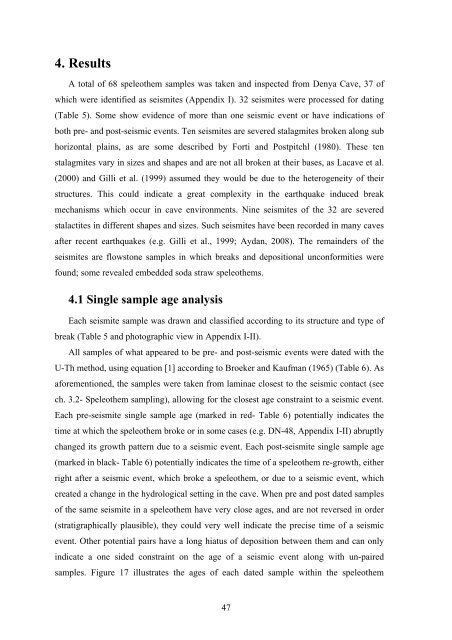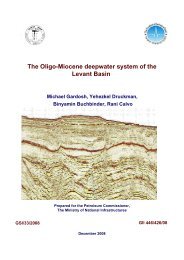tivity on the carmel faul
tivity on the carmel faul
tivity on the carmel faul
You also want an ePaper? Increase the reach of your titles
YUMPU automatically turns print PDFs into web optimized ePapers that Google loves.
4. Results<br />
A total of 68 speleo<strong>the</strong>m samples was taken and inspected from Denya Cave, 37 of<br />
which were identified as seismites (Appendix I). 32 seismites were processed for dating<br />
(Table 5). Some show evidence of more than <strong>on</strong>e seismic event or have indicati<strong>on</strong>s of<br />
both pre- and post-seismic events. Ten seismites are severed stalagmites broken al<strong>on</strong>g sub<br />
horiz<strong>on</strong>tal plains, as are some described by Forti and Postpitchl (1980). These ten<br />
stalagmites vary in sizes and shapes and are not all broken at <strong>the</strong>ir bases, as Lacave et al.<br />
(2000) and Gilli et al. (1999) assumed <strong>the</strong>y would be due to <strong>the</strong> heterogeneity of <strong>the</strong>ir<br />
structures. This could indicate a great complexity in <strong>the</strong> earthquake induced break<br />
mechanisms which occur in cave envir<strong>on</strong>ments. Nine seismites of <strong>the</strong> 32 are severed<br />
stalactites in different shapes and sizes. Such seismites have been recorded in many caves<br />
after recent earthquakes (e.g. Gilli et al., 1999; Aydan, 2008). The remainders of <strong>the</strong><br />
seismites are flowst<strong>on</strong>e samples in which breaks and depositi<strong>on</strong>al unc<strong>on</strong>formities were<br />
found; some revealed embedded soda straw speleo<strong>the</strong>ms.<br />
4.1 Single sample age analysis<br />
Each seismite sample was drawn and classified according to its structure and type of<br />
break (Table 5 and photographic view in Appendix I-II).<br />
All samples of what appeared to be pre- and post-seismic events were dated with <strong>the</strong><br />
U-Th method, using equati<strong>on</strong> [1] according to Broeker and Kaufman (1965) (Table 6). As<br />
aforementi<strong>on</strong>ed, <strong>the</strong> samples were taken from laminae closest to <strong>the</strong> seismic c<strong>on</strong>tact (see<br />
ch. 3.2- Speleo<strong>the</strong>m sampling), allowing for <strong>the</strong> closest age c<strong>on</strong>straint to a seismic event.<br />
Each pre-seismite single sample age (marked in red- Table 6) potentially indicates <strong>the</strong><br />
time at which <strong>the</strong> speleo<strong>the</strong>m broke or in some cases (e.g. DN-48, Appendix I-II) abruptly<br />
changed its growth pattern due to a seismic event. Each post-seismite single sample age<br />
(marked in black- Table 6) potentially indicates <strong>the</strong> time of a speleo<strong>the</strong>m re-growth, ei<strong>the</strong>r<br />
right after a seismic event, which broke a speleo<strong>the</strong>m, or due to a seismic event, which<br />
created a change in <strong>the</strong> hydrological setting in <strong>the</strong> cave. When pre and post dated samples<br />
of <strong>the</strong> same seismite in a speleo<strong>the</strong>m have very close ages, and are not reversed in order<br />
(stratigraphically plausible), <strong>the</strong>y could very well indicate <strong>the</strong> precise time of a seismic<br />
event. O<strong>the</strong>r potential pairs have a l<strong>on</strong>g hiatus of depositi<strong>on</strong> between <strong>the</strong>m and can <strong>on</strong>ly<br />
indicate a <strong>on</strong>e sided c<strong>on</strong>straint <strong>on</strong> <strong>the</strong> age of a seismic event al<strong>on</strong>g with un-paired<br />
samples. Figure 17 illustrates <strong>the</strong> ages of each dated sample within <strong>the</strong> speleo<strong>the</strong>m<br />
47

















